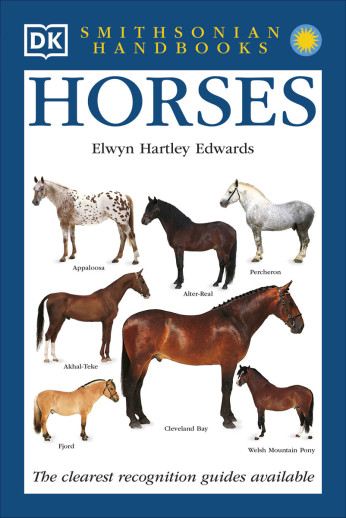We use cookies to make your experience better. To comply with the new e-Privacy directive, we need to ask for your consent to set the cookies. Learn more.
Horses (Smithsonian Handbook) by Edwards
Honestly, of all the books about horses that I've ever seen, this is the one that I would consider the horse Bible. This was the first horse book that I ever owned and through it I got one of the most wonderful horses in the world - but more about that later. The lengthy introduction covers horse breeds, types, temperaments, relatives, conformation, life cycle, color patterns, markings, gaits, sporting and working events, saddles, bridles, bits, origins and more. These pages are packed full of information, pictures, illustrations, etc. The meat of the book is devoted to discussing over 100 individual horse breeds, divided into three sections: ponies, light horses, and heavy horses. Most breeds receive a two-page spread and a plethora of information about that breed including environment, origin, temperament, breeding, characteristics, colors, and uses. Pages also include a map section with a highlighted area of the region the horse originated from, a key showing the types of horses which influenced the breed and the traits that they passed to it, and a silhouette illustration of the horse standing next to a 6' tall man for size comparison along with size ranges. Front and center, of course, is a photograph of the horse which takes up the majority of the page with distinctive points of conformation marked out to assist with breed identification. The end pages include a glossary of equine lingo that not all are familiar with and an index so you can flip back to your favorite breed easily until you have the page memorized. This book was also my art inspiration (horses are the only thing I draw at all well), and I often took this book with me as a guide when I was drawing - my goal was to draw all the breeds, but I never got that accomplished! Besides educating me, this book did something else for me - it was in this book I saw my first picture of a Friesian (pg. 116!!) and then and there I decided that I had to have one at some point in my life (not knowing at the time how expensive they are). I had never even touched one before last spring where, because of this book, I decided that I would do my required internship (for the horse program I was in) at a Friesian breeding facility. I had never seen one up close, but they were still on my mind, so I located a farm up in Minnesota. After two weeks there my dreams came true - my bosses gifted me with an almost two-year old Friesian cross (that's right, he's only half Friesian, but he is gorgeous!) which I named Tonto. It was truly one of the most amazing things that ever happened to me and, of course, I owe it to God and this amazing book! ~ Megan
A visual identity key helps you recognize different horse breeds, and guides you to the correct entry based on what you see and observe. Each entry combines a concise description with annotated photographs to highlight the main characteristics and distinguishing features of the breed, with details on coloring, country or region of origin, breed history, and how the breed has been used in the human world. A concise glossary provides instant interpretation of equine terms.
The clear visuals and distinctive facts are accompanied by expert prose from author Elwyn Hartley Edwards, former editor of Riding magazine and former consulting editor to Horse and Hound. The book is a clear, concise, comprehensive, and indispensable identification guide for beginners and established equine enthusiasts alike.
| Product Format: | Softcover Book |
|---|---|
| Brand: | Dorling Kindersley |
| Author: | Elwyn Hartley Edwards |
| Grades: | 3-AD |
| ISBN: | 9780789489821 |
| Length in Inches: | 8.5 |
| Width in Inches: | 6 |
| Height in Inches: | 0.75 |
| Weight in Pounds: | 1 |

